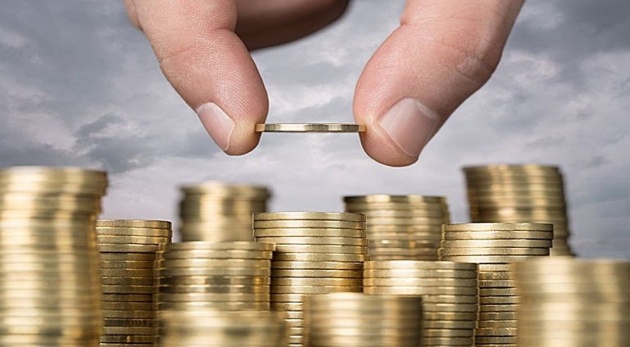
The Basics of Investing: First Lesson - What is Money Investing?
Photo credit: Amber255 via Bitlanders.com
Welcome to read my new blog. This time, I want to talk one more time about money investing. I started this theme in a blog: Investing for Beginners: Easy Steps and Tips to Start Investing. I am very interested in the possibility to make money by investing, and I am taking enough time for learning the basics of investing. My mentor is my cousin who works in investments field a few years already, and I must say that with his help I decided to write a few blogs-lessons about money investing.
I thought about how to make the useful information available to the widest range of users some time already. And here is a first blog- lesson where I will add all my current knowledge. It may seem to you a bit tedious or self-evident, but I hope, for some of you it will be more beneficial than any "free" promise to turn you into a professional investor within 20 minutes. And such promises you can find at every corner, even online.
I do not promise that my knowledge will bring miracles to new investors. Of course, it will not make you one more millionaire the next day. I am also still learning how to make money by investing, but we can learn together. Simply, it's the essence of what we need to know about investing, what every financially literate person should be led by.
Investing For Beginners | Advice On How To Get Started
Video credit: ProjectLifeMastery via Youtube.com
The earlier we get access to training, the more time we will have to learn, repeat, and master the material. The sooner we start investing, the more success will lead us. I will try to write in simple words for better understanding, the same way that I was taught also.
The lessons on how money makes money are for those who sometimes think about ways how to become wealthy, financially independent, how to retire earlier. If you know that you want to but do not know how to start investing and where to invest, this article is for you.
What is an investment?
Each of us has some sort of perception of what is an investment. There are many definitions, but the investment can be defined quite simply. For example, the conversion of existing savings into certain assets (usually stocks, bonds, real estate or investment fund units) with the simple goal of bringing in an additional financial gain in the future.
Or even easier, the purpose of an investment is to increase the invested amount of money in the future. If you invest a hundred dollars today, you want more than one hundred after the year.
While reading my blog, please check Querlo chat:
How to achieve this?
The problem is that starting investors, and sometimes advanced ones, often perceive investment as an uncomplicated activity, when doing nothing, they can make a lot of money, and that investing is a quick way to get rich, and finally have fun on enduring holidays in any exotic country, drinking cocktails on the beach, and so on. It is the misleading approach, and it can cause a lot of mistakes. Such investors suffer losses and get disappointed in investing. To avoid this, I will try to tell you what is really investing, how it works, and how to be able to avoid sometimes quite a lot of costly mistakes that can be made by investing.
Three Basic Steps Before Investing
What do we need to do before we start investing?
- Firstly, before you start investing, you need to accumulate certain savings. This is a recommended step for everyone. For anyone who wants to invest. And not just for them. It is suitable for everyone. First, keep a reserve for the "black day". In most cases, it is recommended to accumulate a reserve size that corresponds to your costs of 3 to 6 months.
- Secondly, you need to take care of how to protect these savings from inflation and money depreciation.
- Thirdly, once you've done the first two, you can start thinking about investing, about increasing the value of accumulated assets.

Save money - Photo credit: nextdeal.gr
Reserve? Who needs it? The reason for the need of a reserve is very simple - it may happen that you lose your job, or your income source will decrease significantly. A reserve, in this case, is necessary in order to be able to think soberly and make further decisions. With a certain saved amount of money, you can make decisions much easier. You will not be hit by the situation and the commitments you have.
What is the amount of money reserve recommended to accumulate?
Expert opinions differ, but the minimum recommended amount is for 3 months. If you want to feel at least a little safer, then you have to accumulate an amount equal to at least 6-12 months of spending.
For example: if your income and, even more importantly, the expenses are about 2000 dollars per month, you need to have a reserve of at least 6 months in order to feel safe. 2000 X 6 months = about $12 000. With such an amount, if you happen to have unforeseen events in the future, if you or your loved ones get some problems, you will probably feel relatively secure. You will have some insurance.
Credit: Abmber255
In order to accumulate, it is necessary to save money
To accumulate something, you have to save some percent of your revenue every month. What part? There are many different offers, but a universal tip is to save at least 10% of your monthly income each month.
For the start, we should accumulate money for the reserve. Then, when the reserve is already accumulated, we can accumulate funds for investment.
You can ask a question: if you earn 1000 - 2000 dollars, is it worth to save 50 - 100 dollars per month? How much will you accumulate? 1000 dollars per year? What's the point? This is not so much a significant amount, so who does it need? It is worth every month to save even 10 or 50 dollars. Just for the purpose to make saving as a routine, a task of each month. To develop a discipline not to spend everything that you earn. Why? Later, when your earnings will begin to increase, costs will increase automatically. Without saving discipline, most often people cannot escape this circle.
A Simple Tricks on How to Save Money
Video credit: BRIGHTSIDE via Youtube.com
If you spend as much as you earn, and you do not accumulate anything and complain that you are lacking in revenue - in other words, you need to make even more money to start investing. For the start, it is good to save 5 percent of income. Later you will be able to save even more. You need to start in order to make it routine, and then the result will automatically improve - you will save more.
Myself, I do not find any problem to save my 10% of income. It is even some kind of fun and encouragement: every month I want to save more and more.
Inflation
However, when you accumulate a certain amount, you automatically receive a problem as a gift that you have not had before. By being able to save a certain amount of money and holding that money in a "pocket", a bank account or some other place, we are faced with the problem of inflation. Inflation is a loss of money.
It's easier to understand by example - you have an account of 1000 dollars, and one year later for that 1000 you will not buy the same product that you looked at last year - as the price of the product will increase over the year.
Inflation - Photo credit: directexpose.com
Inflation is either an increase in the price of a product or a decrease in the value of a monetary unit. In the last 100 years, the average annual inflation in the world was about 3%. We can safely assume that in the future inflation will remain at 3 - 4% and the money kept in the form of net cash will lose its value.
Why is it useful to invest?
I will give an example of two options.
- In one case, a person saves 1000 dollars each year. And this is how he does for 30 years. For example, he is 25 years old and behaves like that until the age of 55. How much does he accumulate over 30 years saving 1000 dollars in the year? 30 000 dollars. However, the inflation has yet to be calculated in. Realistically, after 30 years, he will not buy the same goods or services that would have been able to buy for the same amount earlier.
- In the second case, a person sets aside the same 1000 dollars, but each year he invests all the saved dollars. Suppose that he earns 5% of his investment every year. That is, every one of his 1000 dollars annually earns 50 dollars. What happens? After the same 30 years, the accumulated amount is already not 30,000 dollars, but much higher.
This is a very simple but fairly eloquent example of the great difference between saving and investing. It should prove that investing is beneficial.

Why is it useful to invest? - Photo credit: investblog.kz
Once we find out that each of us must accumulate a reserve for bad days before starting to invest and increase the portion of a monthly revenue, and once we understand that investing of our savings for at least a longer period is more profitable than simply saving, we should ask ourselves - where can we invest? What the investment types can we choose?
Money investment types
There are usually three major money investment types in the world:
- The simplest and most popular is cash or deposits.
- The second most popular way to invest in the world is to buy bonds or, alternatively, debt securities.
- The third most popular way is to invest in the business by purchasing shares of specific companies.
In addition to these three major money investment types (which are particularly popular in the Western world, such as Germany, Britain, and America), you can invest some money in alternative investment instruments such as real estate, raw materials or gold. Each of us can invest in all of these types - in other words, we now know where we can invest.

Investment Types - Photo credit: bitcointalk.blog
Invest safely or aggressively?
Knowing where we can invest, we can briefly explore a couple of extreme choices - which way an investor can go and which type to invest in. Where to invest depends on many things, but we will learn more about these things in other lessons.
One extreme case is when the purpose is equal to security. The purpose of such an investor is to preserve the available money so that they do not devalue due to inflation. The choice of such a person should be - cash, deposits or short-term state bonds.
Another extreme case is a young man who is planning to increase money and invest for a long time, say 30-40 years. He is not at all afraid of risk, not afraid of short-term losses. To such an investor may be offered riskier investment types, such as shares or real estate, with a higher risk but also a higher probable profitability.
In this lesson, we do not yet get deeper how much returns we can expect from investing in different asset types, and I will do this in other lessons.

Basics of Investment - Photo credit: cryptoblog.fishkaann.ru
Compound interest rate
Another argument why investing is meaningful is a process called a compound interest rate.
Most often, before investing, we are thinking the following: if I will earn 10,000 dollars, and every year I will earn 10% profit on average, I will earn 10% annually. And if I invest ten, twenty or thirty years, it means I will earn about 1000 dollars each year.
An example of such thinking would be this: if I invest 10 000 dollars for ten years, I earn 10% annually, then after 10 years I will accumulate the sum of 20 000 dollars. The initial investment of $10,000 and $1,000 annually.
However, if we decide to invest, it is advisable to invest also all the profit that we earn every month and year, to keep it as an investment until we reach our investment goal. If we do this, it turns out that every year we invest a thousand dollars more than a year earlier.
An example of this behavior: In the first year you invested $10,000, and you earned 10 percent, so you already have $11 000. In the second year, earnings have already been calculated from $11,000. And so every year. Each year the return is the same - 10%, but the amount invested is increasing - it means that we earn interest on interest. Exactly this term is called the compound interest rate.

Compound Interest Rate - blog.performancehorizon.com
By comparing the situation when only the initial investment is invested, and the profit is taken out annually from the investment, with the situation when the earned interest is left to invest again, the final accumulated amount may vary from 30 to 50 percent within 10 years - it depends on how much you will earn each year.
To sum up, if you do not spend your profit every year, you'll earn more at the end of the period than if you would take out the profit every year.
Start saving money as soon as possible
We often hear such recommendation. Why? To illustrate why this is useful, let's give you two examples.
We imagine that one investor starts investing at the age of 25. Starting an investment is $10 thousand. The second begins to invest over 35 years of age, having the same 10,000 dollars. If we compare their results after a fairly long period, for example, when they reach 55, we will see that a person who has started investing earlier will accumulate more drastically than the person who invested in later years. There is a very simple rule: the sooner you start investing and the more stable you will accumulate and put aside a certain amount of money, the more money you will earn in the future.
It's important to realize that you can accumulate really impressive amounts of money in 20-30 years, using the so-called compound interest. They are most likely to be useful for your child' studies, paying out a home loan or ensuring a good old age.

Start to Save Money - Photo credit: radio2.be
How much does an investor make?
In my given examples, I used 5 or 10 percent of our investment returns of annual profitability. We have not yet talked about how much we can earn from different investment types, so now let's answer the question "What kind of return on investment should my portfolio or my accumulated capital be in the next 10 or 20 years so that I would say that I'm a successful investor?"
5%? 10% 20% Or maybe someone would like to achieve 100% annual profitability?
It is said that if in the next 10, 20 or 30 years your average annual return on investment will be 9 or 10 percent (after deducting all taxes) you will surely be able to claim that you are a successful investor. Maybe you will not become the richest person in the world, but you will be doing much better than most people around you.

How to Start Investing - Photo credit: facebook.com
On the final note
To sum it up, the most important things you need to do:
- You need to create a reserve for the bad days. Its size could be at least 3-6 months. This will be an amount of money for your expenses. You will feel safer.
- To avoid money depreciation (due to inflation), you have to start investing. There are many tools to do this.
- Investing should be started as early as possible in order to feel the investment benefits as early as possible.

Successful Investor - Photo credit: blog.cashinasnap.com
Lastly, remember that you need to invest everything you save. You can hide money from thieves, but inflation will find them everywhere.
If you do not invest, your financial goals will be even harder for you, because in the future, what you want to buy will constantly raise the price and your savings will go down. If you have a personal budget, and you already have the first savings, you can start thinking about investing.
***************************************************************************************************
Thank you for stopping by and reading my blog.
2018, All Rights Reserved.
You are very welcome to join Bitlanders and share your valuable knowledge and opinion.
***************************************************************************************************
You can check my other blog about investing:
1. Investing for Beginners: Easy Steps and Tips to Start Investing
Come back to find more...
**************************************************************************************************



